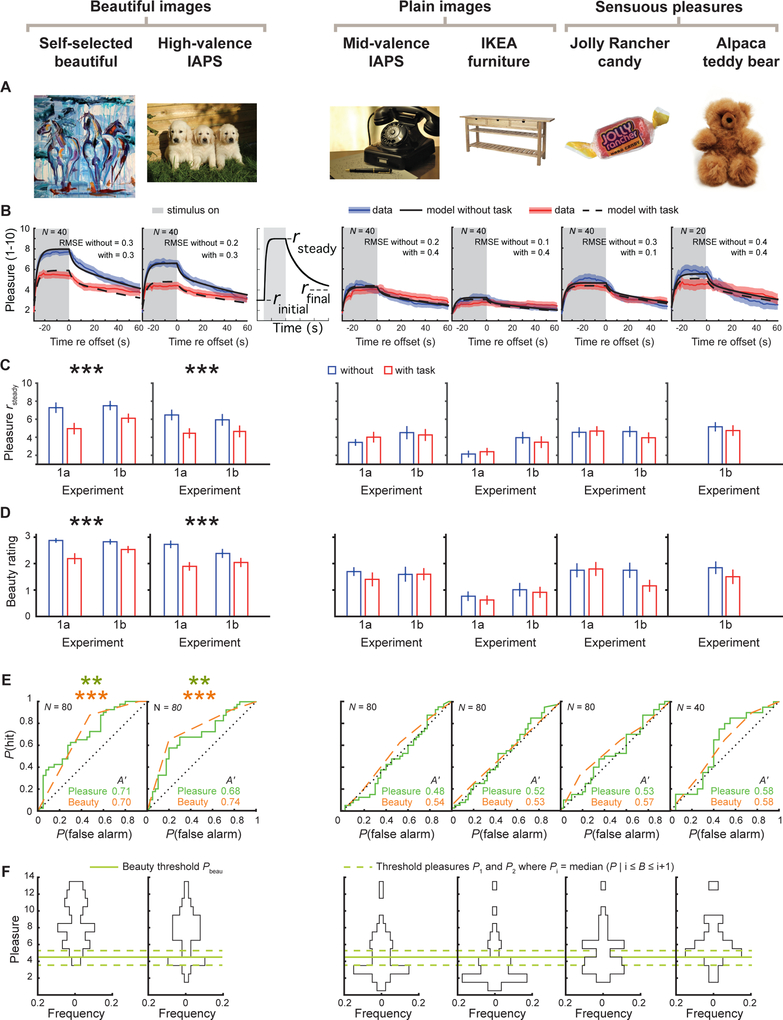Figure 1. Main results of Experiment 1.
(A) Examples of the six kinds of stimulus. (B) Time course of the pleasure rating (colored) and model fit (black) in Experiment 1 for each stimulus kind for trials without (blue and solid-black) and with (red and dashed-black) the added task requiring thought. The grey shaded area indicates the stimulus duration. A schematic of the model (Eq. 1) used to fit pleasure ratings is shown in the gap between beautiful images and the remaining stimuli. Colored lines with shaded areas represent mean ± 1 SE of the data. RMSE = root mean square error of the model fit across the entire 90 s trial duration; N = number of trials (and participants) per curve. Experiment 1 combines 1A and 1B, which each had 20 participants, for a total N = 40. (C) Mean estimated steady-state response rsteady for each kind of stimulus for trials without (blue) and with (red) an added task. Error bars represent mean ± SE. Across Experiments 1A and 1B, average rsteady estimates were 2.1 and 1.8 (on the 1 – 10 pleasure scale) lower in trials with an added task for self-selected beautiful and high-valence IAPS images, both p < 0.001, task × stimulus interaction F(4,152) = 7.99, p < 0.001. rsteady pleasure values for all other stimulus categories were unaffected, all p ≥ 0.407. There was no three-way interaction, F(4,152) = 1.86, p = 0.120. Interactions were tested with a 2 × 2 × 5 (task × experiment × stimulus kind) repeated measures ANOVA (rmANOVA) that excluded the teddy bear stimulus only presented in experiment 1B. A separate rmANOVA confirmed that there was no effect of added task on teddy bear trials, F(1,19) = 0.44, p = 0.513. Asterisks designate significant differences, without vs. with added task, according to post-hoc pairwise comparisons: *** p < 0.001. (D) Average final beauty judgment in Experiment 1 for each kind of stimulus for trials without (blue) and with (red) an added task. Error bars represent mean ± SE. Despite the three-way interaction of task, stimulus, and experiment, F(4,152) = 2.64, p = 0.031, separate repeated-measures ANOVAs per stimulus kind showed the same pattern of results as for pleasure rsteady: Average final beauty judgments were 0.5 and 0.6 (on our 0 – 3 scale) lower in trials with an added task for self-selected beautiful and high-valence IAPS images, both p < 0.001. Beauty judgments for all other stimulus categories were generally unaffected, all p ≥ 0.081. The only interaction of task and experiment was observed for candy, F(4,152) = 4.49, p = 0.041, all other p ≥ 0.098. For candy, the added task decreased beauty judgments in Experiment 1B by 0.6, p = 0.009, but the similar 0.5 reduction in Experiment 1A was not significant, p = 0.819. Asterisks designate significant differences according to post-hoc pairwise comparisons between trials with and without added task: ** p < 0.01, *** p < 0.001. (E) Receiver-operator-characteristic (ROC) curves [23] for classification of trials as with or without added task based on final beauty judgments (orange) and average pleasure during stimulus exposure (green) in Experiment 1. An area under the curve (A’) greater than 0.5 indicates better-than-chance decoding of task presence; asterisks (orange for beauty and green for pleasure) designate significant deviations of A’ from 0.5 based on bootstrap tests [24]: ** p < 0.01, *** p < 0.001. (F) Vertical histograms (binned scatter dot plots) of pleasure per stimulus kind for trials without task. The dashed lines indicate the estimated threshold pleasures P1 and P2 for perhaps and definitely feeling beauty, where Pi = median (P | i ≤ B ≤ i+1), calculated as the median, across stimulus kinds, of the median pleasure for trials with beauty rating in the range [1 2] for P1 or [2 3] for P2. Between the dashed lines, the green line indicates the threshold pleasure Pbeau = 4.29 for effect of added task (see Figure 2). See also Figure S1–4 and Table S1–2.

